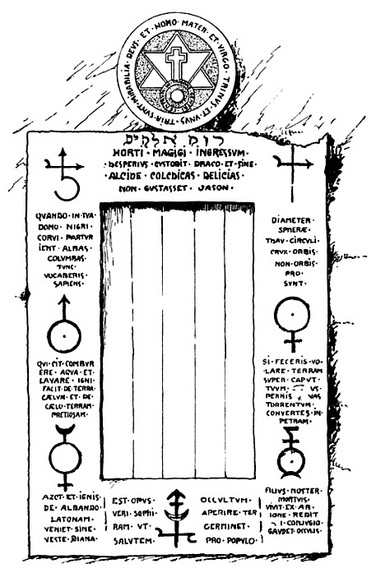JASON AND ALCHEMY
17th Century
Jason's adventures in Colchis in search of the Fleece were early on equated to the practice of alchemy, with the Golden Fleece standing in for the golden reward of a successful alchemical experiment. In 1894 in the Journal of American Folklore Henry Carrington Bolton (1843-1903), a chemist and historian of chemistry, discussed the alchemical symbolism of the Porta Alchemica (or Porta Magica) in Rome, a door built in 1678 or 1680 for the villa of Massimiliano Palombara, a Roman nobleman with a deep interest in alchemy. Here, the author describes the Argonautic symbolism on the door with an extensive quotation from Johann Rudolf Glauber (1604-1674), a German alchemist and chemist:
|
On the door jamb, beneath the Hebrew words, is the inscription :--
(C.) Horti magici ingressum Hespcrius custodit draco et sine Alcide Colchicas delicias non guslasset Jason. "A dragon guards the entrance to the magic garden of Hesperius; and without the aid of Alcides [Hercules] Jason would not have tasted the delights of Colchis." Alchemistic authors were wont to claim that the Argonautic expedition symbolized the search for the Philosophers' Stone. This theory is as old as Dionysius of Mitylene, who lived about 50 B. C. Glauber, the German physician, records this interpretation in the following quaint language: "When ancient Philosophers by poetical parables described the laborious navigation of Jason to the island Colchos, where resided a huge dragon vomiting fire, which with eyes never closed, diligently watched the golden fleece, they added this, viz., that Jason was taught by his wife Medea to cast to this waking dragon an edible medicine to be swallowed, whereby he should be killed and burst; and that Jason should presently take the dragon (thus slain) and totally submerge him in the Stygian lake. Jason in this ingenious fable hieroglyphically represents the philosophers; Medea accurate meditations; the laborious and perilous navigation signifies manifold chymical labours; the watching dragon vomiting fire denotes salt-nitre and sulphur; and the golden fleece is the tincture or soul of sulphur, by the help of which Jason restored health to his aged father, and acquired to himself immense riches. By the pills of Medea is understood the preparation of sulphur and sal mirabile. By the total submersion of the dragon in the Stygian lake is intimated the fixation of sulphur by Stygian water, that is, Aqua Fortis. Whence it is sufficiently clear how obscurely the ancient Philosophers did describe their fixation of sulphur by nitre, and how secretly they hid it from the eyes of the unworthy." Source: Henry Carrington Bolton, "The Porta Magica, Rome," The Journal of the American Folklore Society 7, no. 24 (Jan.-Mar. 1894), 77. Image at left from page 76. |
Satiric View
This type of alchemical mumbo-jumbo was parodied in Ben Johnson's The Alchemist (1610), a satiric play in which Sir Epicure Mammon utters the following lines:
I have a piece of Jason’s fleece, too,
Which was no other than a book of alchemy,
Writ in large sheepskin, a good fat ram-vellum.
Such was Pythagoras’ thigh, Pandora’s tub;
And all that fable of Medea’s charms,
The manner of our work: the bulls, our furnace,
Still breathing fire: our argent-vive, the dragon:
The dragon’s teeth, mercury sublimate,
That keeps the whiteness, hardness, and the biting;
And they are gathered into Jason’s helm,
(The alembic [a type of still]), and then sowed in Mars his field,
And thence sublimed so often, till they’re fixed.
Ben Jonson, The Alchemist, II.i.89-104, edited by H. C. Hart (London: De La More Press, 1903), slightly modernized.
This passage alludes to the famous theory that the Golden Fleece was in fact a book of alchemy written on vellum (sheep's skin), with Jason's trials representing pieces of an alchemical apparatus.




